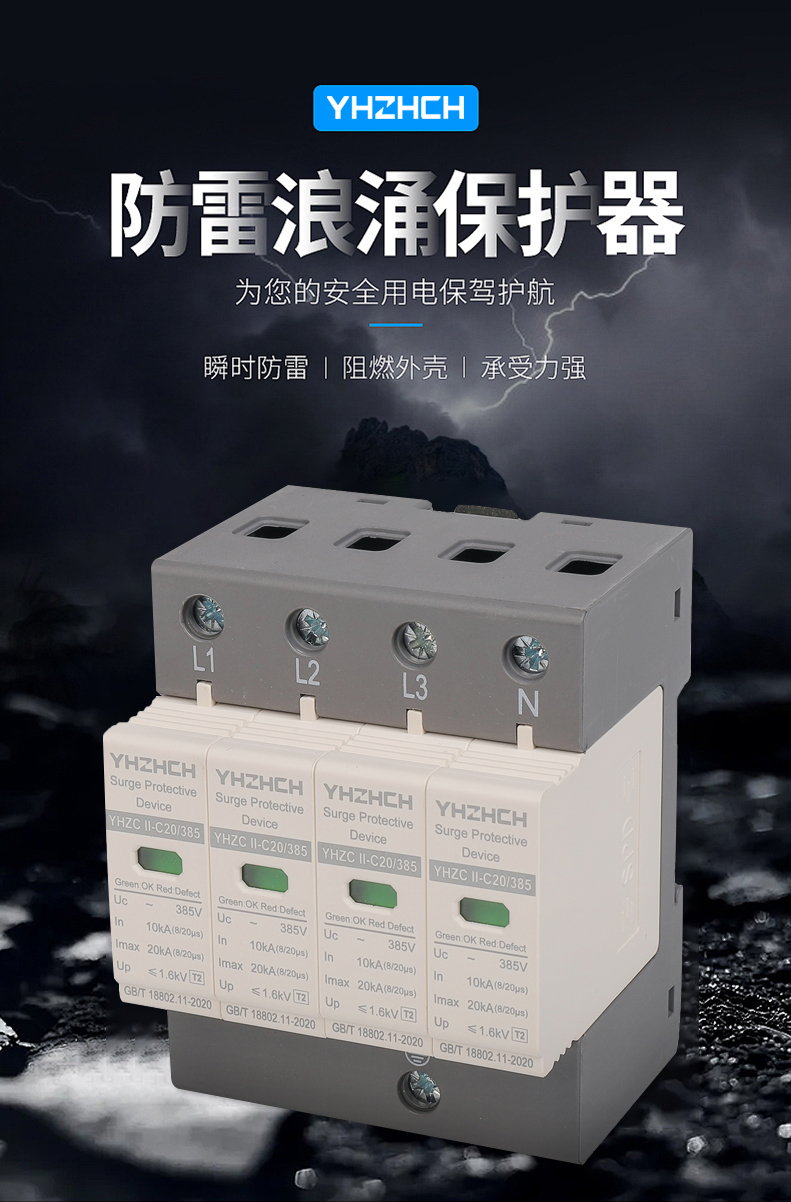For surge protectors, choose products from Shenzhen Yunhai Power Technology Co., Ltd., the original manufacturer, with discounted prices and peace of mind~
Surge protectors (SPDs) can be classified into various types based on their structure, principles, and application scenarios, and their applicable scenarios are closely related to their performance characteristics. The following is an analysis of common types and their corresponding applicable scenarios:
1、 Classified by working principle
1. Voltage switch type (gap type) surge protector
Principle: Using a discharge gap (such as a gas discharge tube), when the voltage exceeds the threshold, the gap breaks down and conducts, releasing surge energy.
Features: Slow response speed (nanosecond level), strong current carrying capacity, suitable for high-energy surge impact.

Applicable scenarios:
Front end protection of power systems: such as high-voltage incoming lines in substations and distribution rooms, used to suppress high-intensity surges caused by direct lightning strikes or the start stop of large equipment.
Industrial field: Power supply lines for heavy industrial plants, large motors or transformers to withstand sudden overvoltage in industrial environments.
Outdoor equipment: such as power lightning protection for base stations, street lights, and outdoor monitoring systems, to cope with natural impacts such as lightning strikes.
2. Voltage limiting type (voltage limiting type) surge protector
Principle: Based on nonlinear components such as varistors (MOVs) and TVS diodes, the impedance rapidly decreases when the voltage exceeds the threshold, limiting the voltage amplitude.
Features: Fast response speed (in picoseconds), low residual voltage, but relatively weak current capacity.
Applicable scenarios:
Backend protection for precision electronic equipment, such as UPS power supplies, switches, computers, etc. in server rooms, data centers, and laboratories, to prevent damage to sensitive circuits caused by surges.
Household appliances: power ports for high-end appliances such as air conditioners, televisions, and refrigerators to reduce the impact of power grid fluctuations or small surges.
Signal line protection: such as RJ45 interfaces for network cameras, routers, and cable TV signal ports, to protect data transmission equipment from induced lightning strikes.
3. Composite surge protector
Principle: Combining voltage switch type and voltage limiting type components, wide range protection is achieved through multi-level protection (such as front stage discharge gap+rear stage varistor).
Features: Balancing current capacity and response speed, it can suppress surges of different energies in stages.
Applicable scenarios:
Complex electrical environment: such as the distribution system of commercial buildings (floor distribution boxes, unit distribution boxes), which can not only cope with the high-energy impact of direct lightning strikes, but also handle the subsequent continuous overvoltage.
Hybrid equipment system: A scenario in industrial automation production lines that includes both strong electrical equipment (motors) and weak electrical equipment (PLC controllers), providing full chain protection.
Intelligent buildings: The main incoming and branch power lines of office buildings and shopping malls meet the requirements of multi-level lightning protection zones (LPZ0, LPZ1, LPZ2).
2、 Classified by installation location and purpose
1. Surge Protection Device (SPD) for Power Supply
Types: including Level 1 (B), Level 2 (C), and Level 3 (D) protection.
First level protection: mostly switch type, installed in the main distribution room, to deal with direct lightning strikes (such as 10/350 μ s waveform surges).
Secondary protection: Composite or voltage limiting type, installed in the floor distribution box, to handle induced lightning or switch surges (such as 8/20 μ s waveform).
Third level protection: pressure limiting type, installed at the front end of equipment (such as sockets, cabinets), to protect precision equipment at the end.
Applicable scenarios:
Construction field: graded protection of power distribution systems for residential, office, and factory buildings.
Industry and Energy: Power systems for photovoltaic power plants and wind turbines to resist lightning strikes and electromagnetic pulses in outdoor environments.
Communication field: AC/DC power supply incoming lines for base stations and computer rooms to ensure stable operation of communication equipment.
2. Signal Surge Protector (SPD) for Signal Lines
Principle: Designed for different signal types (such as network, video, RF) to suppress transient overvoltage on the circuit.
Type:
Network signal SPD: protects data lines such as Ethernet (RJ45) and fiber optic cables.
Video signal SPD: HDMI and BNC interfaces used for monitoring cameras.
RF signal SPD: Suitable for wireless communication antenna feeders (such as N-type, SMA interfaces).
Applicable scenarios:
Security monitoring system: The signal transmission line of outdoor cameras to prevent lightning from damaging the hard disk recorder (NVR).
Radio, television, and communication: The RF signal link of television transmission towers and wireless base stations protects the transmitter and receiver.
Industrial automation: Sensor networks and PLC control signal lines in factories to resist electromagnetic interference (EMI) and surges.
summarize
The selection of surge protectors should be based on the voltage level, surge risk, equipment sensitivity, and installation location of specific scenarios. Through graded protection and type matching, efficient protection of power systems, electronic equipment, and signal links can be achieved. For example, switch type is preferred for outdoor high-voltage scenarios, pressure limiting type is relied upon for indoor precision equipment, and composite or multi-level combination schemes are required for complex systems.


